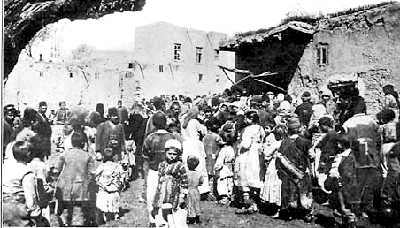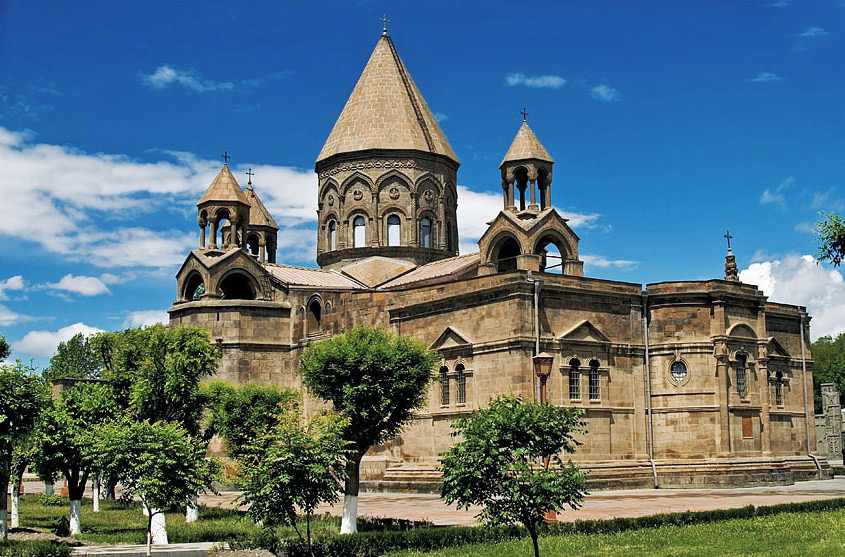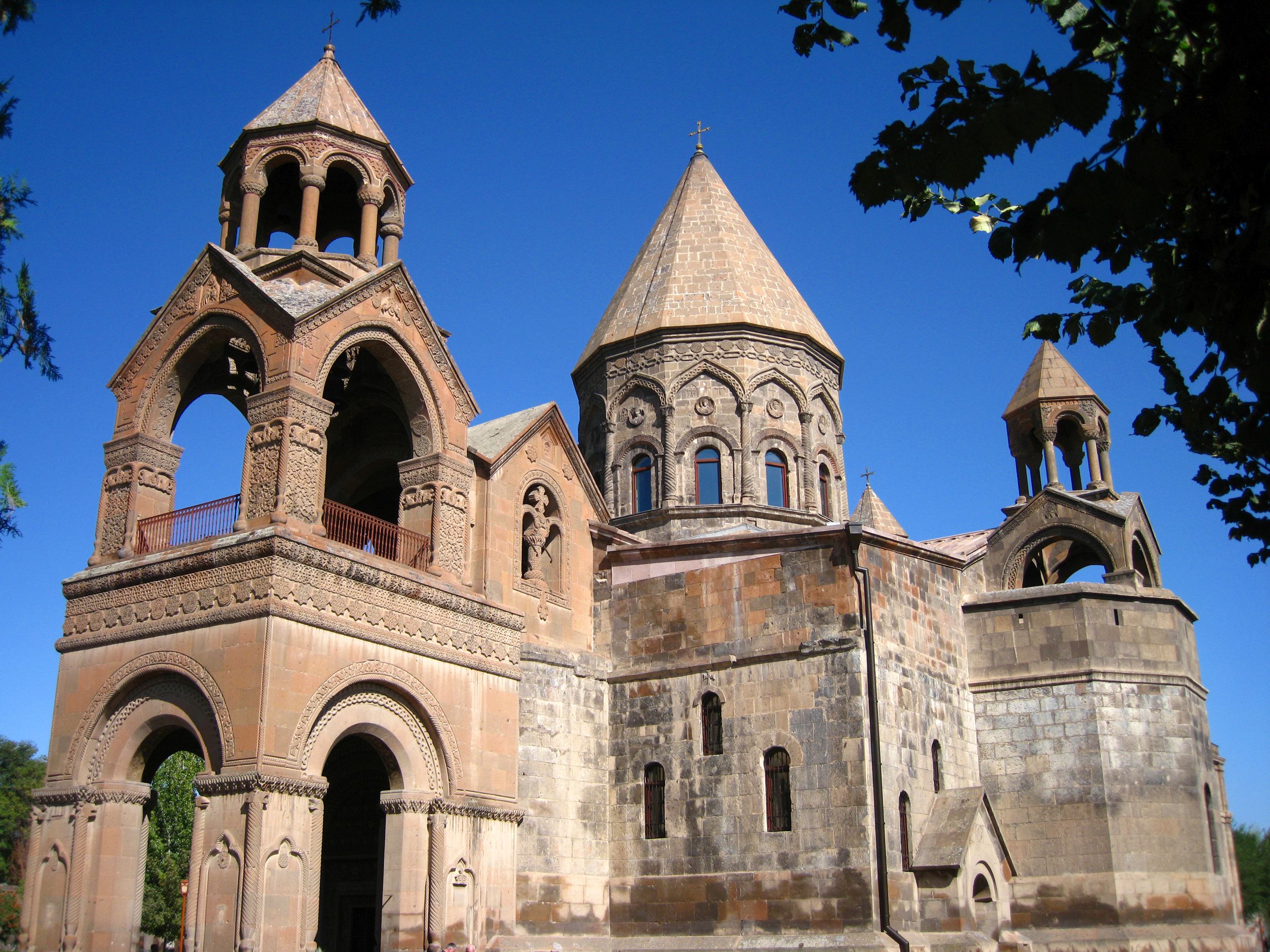Etchmiadzin, 1915-1917: Armenian Genocide Refugees and Russian Imperial Humanitarianism
While Russian and Ottoman imperial troops fought on the Caucasus front of World War I, Turkish authorities targeted hundreds of thousands of Ottoman Armenian subjects as a potential ‘strategic threat.’ As a result, Ottoman Armenians were massacred or deported to the deserts of Mesopotamia. Those who did not fall victim became refugees first in the immediate vicinity and particularly along the Ottoman-Russian border. The Russian imperial government as well as a number of relief organizations assisted these refugees. Etchmiadzin, the Armenians’ religious center in the Russian Empire’s southwest, became a major refugee town.
The Russian Empire had a vast Armenian population in Transcaucasia, spread from the Kars region to the Black Sea coast and Tbilisi, and from the Caspian Sea and Baku to the Russo-Iranian border. Between summer and fall 1915, this region was flooded with somewhere between 120,000 and 150,000 refugees forced to abandon their homes and cross the Russian-Ottoman border. In August 1915, the number of refugees in Etchmiadzin was reportedly 30,000. Despite its historical and religious significance as the center of the Armenian Apostolic Church Etchmiadzin had been a small town with a population of less than 6,000 people before the Great War. Therefore, sheltering that great number of refugees was a huge challenge. The condition of Armenian refugees was alarming and the need for assistance urgent. Thus, Russian political and public figures pressed for relief work in order to confront this emergency immediately. In July 1915 Mikhail Papadjanov, the Russian State Duma representative for Baku, Yelizavetpol, and Erivan regions, in his speech at the Duma attempted to bring the Turks’ violence against Armenians to wider attention. Historian and politician Pavel Miliukov held that assisting Armenian refugees was crucial not only for saving lives of individuals, but also for ensuring ‘the survival of a nation, whose existence was a key to the success of Russian cultural mission in Turkish regions.’ (Osherovskii 1915: p. 23)

What motivated the Russian civil and military authorities to engage with the problem of Armenian refugees? Because of a variety of actors engaged, there were a variety of agendas. Thus, besides humanitarian sentiments and compassion in Russian governmental circles as well as among ordinary people, many other factors obtained. Among those were the self-perception of the Russian Empire as the ‘protector of all Christians of the Orient’ and the historic ties between Russians and Armenians. Since the Treaty of Küçük Kaynarca (July 21, 1774) signed by the Russian and Ottoman empires, Russia was assigned some rights of protection over the Ottoman Christian subjects throughout the Balkans. Because of the Russo-Turkish War of 1828-1829, Russia gained most of the eastern shore of the Black Sea, and the sultan recognized Russian sovereignty over Georgia and parts of present-day Armenia. The Treaty of Berlin that followed the Russian-Turkish war of 1876-77 contained explicit clauses of minority protection. Ever since the Russian Empire was regarded by Armenians as a protector from Muslim domination and from perpetual persecutions in the Ottoman Empire. Armenians therefore welcomed Russian forces advancing towards the Caucasus and the Eastern Ottoman territories during the Russo-Turkish wars and trusted in better future under the Russian rule. As the Caucasus was one of the most diverse and strategically significant regions of imperial Russian territories, having Armenians as loyal subjects was important for the Tsar. Hence, responding to developments in the Ottoman Empire and on the front, as well as unflagging appeals by Armenians to intervene and stop the violence, in 1914 the Tsar assured the Armenian Catholicos George V that after the war the Armenian question would be resolved in accordance with Armenian expectations.

A further, strategic reason for the refugee assistance was the need to resolve the emergency caused by the refugees in order to secure Russian military success. The influx of hundreds of thousands of refugees to the Caucasus from the Ottoman Empire created an immense humanitarian crisis at the border and in the interior. These developments were tragic for the Armenian people and highly problematic for the Russian civil and military authorities, whose first goal was to win the war. Thus, a number of public organizations as well as governmental institutions, the Committee of Her Highness Grand Duchess Tatiana Nikolaevna, the All-Russian Union of Towns, and the Russian Society of the Red Cross among others, initiated refugee relief work.
Although the assistance to Armenian refugees was effective and saved thousands of lives, there has been a dispute on the Russian motivation for humanitarian action. Scholars like Avetis Harutyunyan and Manoug Somakian among those have labeled it ‘imperialistic’, merely directed to solve the urgent military concerns of the Caucasus army. Harutyunyan does not use the terms “humanitarianism” or “humanitarian assistance” at all to describe the actions of Russian authorities and organizations. Although the Russian Empire’s population provided tremendous moral and financial support to the Western Armenians, Harutyunyan believes that Russian imperial authorities never actually aimed at protecting or helping Armenians. The state’s involvement in relief work was just the ‘by-product’ of Russian imperialist and colonization policies.

Arguments revolve also around plans by some imperial authorities regarding the Eastern Turkish provinces occupied by Russian forces and opportunities for colonization this provided. During various periods of the war, many of the Armenian refugees from those regions were not allowed to return to their homes even after the Russian advance. Furthermore, in February 1915, Alexander Krivoshein, the Russian Empire’s Minister of Agriculture, suggested settling Erzurum, Van, and Bitlis with Cossacks to promote the colonization of Western Armenia and to support the Caucasus Fourth Army with food supplies. Somakian sees this colonization project as the only reason for Russian interest in Armenians of the region, and Harutyunyan calls these policies anti-Armenian. Historian Peter Holquist, by contrast, argues that Krivoshein’s project was only a suggestion, not official state policy. He believes that the Russian government did not in effect have a coherent plan or project for those regions when the war was waged, and that urgent military interest, rather than an anti-Armenian policy or a colonization plan, shaped those decisions.
Historian Halit Akarca calls Russian policy in Eastern Turkey during the Great War a “‘humanitarian’ occupation” and believes that it evolved and changed in time and was motivated by strategic and political concerns. The Russian state, according to Akarca, was trying to meet the needs of various ethnic groups in its efforts to rule over the multinational population in the occupied regions as an empire. Thus, the developments in the Russian-occupied eastern provinces of the Ottoman Empire were no different from policy Russia pursued elsewhere at the time, and did not target Armenians alone.
Canadian academic and former politician Michael Ignatieff argues that, “Humanitarian action is not unmasked if it is shown to be the instrument of imperial power. Motives are not discredited just because they are shown to be mixed.” (Ignatieff 2003: p. 23) Taking into account the discourse among historians and scholars regarding the genuine sentiments of Russian authorities at the Caucasus front of the Great War, it is therefore crucial to highlight that, whatever the motivations, the recognition of an emergency situation transformed political and public reaction in imperial Russia into organized and efficiently implemented humanitarian action through Armenian relief work.
Further Reading
- Akarca, Halit D. Imperial Formations in Occupied Lands: the Russian Occupation of Ottoman Territories During the First World War (PhD Dissertation, Princeton University, 2014).
- Bloxham, Donald. ‘Internal Colonization, Inter-imperial Conflict and the Armenian Genocide’. In Empire, Colony, Genocide: Conquest, Occupation, and Subaltern Resistance in World History, edited by Dirk Moses, (Oxford: Berghahn Books, 2008): pp. 325-343.
- Darbinyan, Asya. ‘Humanitarianism and the Refugee Crisis on the Caucasus Battlefront During World War I’. The Armenian Weekly Magazine (April 2016), https://armenianweekly.com/2016/05/20/darbinyan-2016-april-magazine/ [30 January 2018].
- Gatrell, Peter. A Whole Empire Walking: Refugees in Russia during World War I (Bloomington: Indiana University Press, 2005).
- Harutyunyan, Avetis. ‘Tsarizmi gaghutain kaghakakanutiune Arevmtian Haiastanum (1914-17tt.)’ [Tsarism’s Colonization policy in Western Armenia]. Baikar Armenian Monthly IV, No 5-6, (1996): pp. 30-34. [Armenian]
- Harutyunyan, Avetis. ‘Rusahaieri ognutiune hai gaghtakannerin arajin ashkharhamarti tarinerin’ [Russian-Armenians’ Assistance to Armenian refugees during the First World War]. History 1, (2002): pp. 108-114. [Armenian]
- Holquist, Peter. ‘The Politics and Practice of the Russian Occupation of Armenia, 1915-February 1917.’ In A Question of Genocide: Armenians and Turks at the end of the Ottoman Empire, edited by Ronald G. Suny, Fatma M. Göçek, and Norman M. Naimark, (New York: Oxford University Press, 2011): pp. 151-174.
- Ignatieff, Michael. Empire Lite: Nation Building in Bosnia, Kosovo and Afghanistan (London: Vintage, 2003).
- Osherovskii, L. Tragedia Armian-bezhentsev [The Tragedy of Armenian Refugees] (Piatigorsk, 1915). [Russian].
- Somakian, Manoug J. Empires in Conflict: Armenia and the Great Powers, 1895-1920 (London: Tauris Academic Studies, 1995).
Short Biographical Note on Contributor
Asya Darbinyan is a PhD Candidate at the Strassler Center for Holocaust and Genocide Studies, Clark University, Worcester, MA. Her dissertation explores the Russian Empire’s response to the Armenian Genocide and to the refugee crisis at the Caucasus front of the Great War. Asya worked at the Armenian Genocide Museum-Institute, Yerevan, as a senior research fellow and the Deputy Director of the museum (2008-2013). Asya was a participant of the Global Humanitarianism Research Academy 2017.
